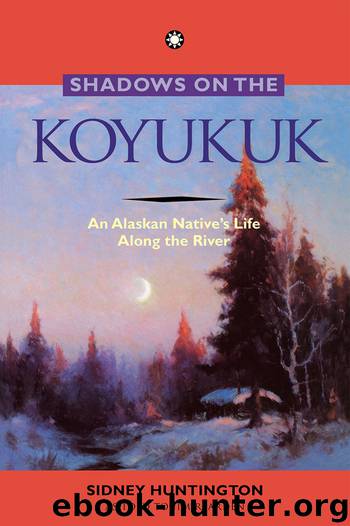Shadows on the Koyukuk by Sidney Huntington

Author:Sidney Huntington
Language: eng
Format: epub
ISBN: 9780882409306
Publisher: Alaska Northwest Books
During the years on the trapline, I learned to love the challenge of building useful items. I made many snowshoes, using techniques I learned from Eklutna John. I also built many dogsleds of split birch. Dogsleds cannot be screwed, bolted, or nailed together because such joints will not withstand the twisting and jolting of the trail. Instead, babiche lashing is used. After soaking, the wet rawhide shrinks as it dries, tightening the joint. Babiche allows a sled to bend and twist without splitting the stressed wood as it bounces over rough trails.
Jimmy and I whipsawed many feet of lumber, planed it, and made sturdy tables, chairs, cabinets, and shelves for our cabin, as well as more boats.
I decided that I wanted to play a musical instrument. We had no battery radios in the early years, but we did have a windup phonograph with some hoedown records, the kind of music played at village dances where the violin and guitar are popular.
The Koyukon people began playing fiddles in the late 1800s, obtaining instruments from Canadian trappers. Later, Irish and Scottish gold rushers brought more violins and more fiddle songs. And Koyukon people composed many songs of their own. Most Indian fiddlers learn to play by ear; many never learn to read music.
I found time between trapping chores to make a guitar. It had a good sound, but it was not as handsome as a store-bought instrument. Next, I made a violin, basing my design on a picture in a Sears, Roebuck and Co. catalog. To make glue for it, I boiled a moose hoof. The handle was maple, the fingerboard ebony, the top was birch, and the back and sides were spruce. I colored the spruce by treating it with acid.
I worked for days steaming, bending, carving, and sanding, closely following the design of the picture. In the spring, I ordered strings and a bow from Sears. For many years, Jimmy and I played that violin at dances all up and down the Yukon. My moose-hoof glue didn’t hold well, and in wet weather the violin started to come apart, so I bought some good commercial glue, reglued it, and we used it again for a while. But one summer I left it at our cabin at Hog River, and while I was gone the roof leaked and the violin got wet and came apart again, and I never reassembled it.
On days too stormy or too cold for working our traplines, and between trapping seasons, I used to study mechanical magazines, where I read about the universal inventors’ goal of creating a perpetual motion machine. About 1931 I decided I could solve that age-old problem; my machine would run forever.
I spent months designing various parts, soldering and whatnot to shape a wheel-like contraption with arms that flopped out on one side and folded as they came up on the other. The weight and movement of the arms caused it to turn continually. My “invention” did quite well; once it turned on its own for almost an hour.
Download
This site does not store any files on its server. We only index and link to content provided by other sites. Please contact the content providers to delete copyright contents if any and email us, we'll remove relevant links or contents immediately.
| Fantasy | Gaming |
| Science Fiction | Writing |
We Ride Upon Sticks by Quan Barry(33276)
The Secret History by Donna Tartt(16608)
Norse Mythology by Gaiman Neil(11874)
Crooked Kingdom: Book 2 (Six of Crows) by Bardugo Leigh(11282)
The Betrayed by Igor Ljubuncic(11218)
The Betrayed by Matthew Dickerson(11059)
Caraval Series, Book 1 by Stephanie Garber(9028)
Year One by Nora Roberts(8467)
Oathbringer by Brandon Sanderson(8434)
The City of Brass by S. A. Chakraborty(7762)
The Priory of the Orange Tree by Samantha Shannon(7318)
Red Rising by Pierce Brown(7317)
Confessions of an Ugly Stepsister by Gregory Maguire(7200)
Twilight Siege: A Dark Fantasy Novel (The Fae Games Book 2) by Jill Ramsower(6232)
Shalador's Lady by Anne Bishop(6217)
Little Fires Everywhere by Celeste Ng(6134)
Storm and Silence by Robert Thier(5886)
Shadows Of The Apt [01] - Empire in Black and Gold by Adrian Tchaikovsky(5871)
This Is How You Lose Her by Junot Diaz(5753)
